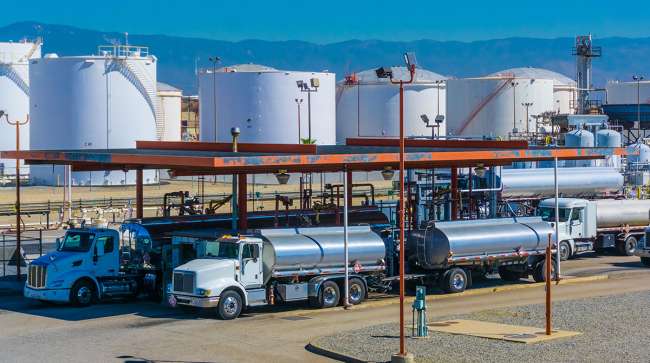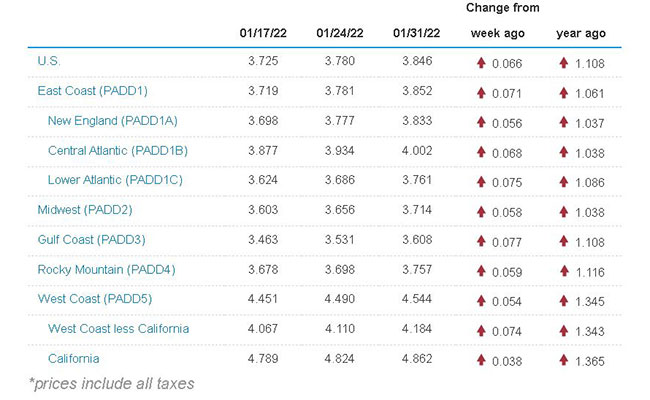Staff Reporter
$4 a Gallon in Range as Diesel Climbs 6.6¢ to $3.846

[Stay on top of transportation news: Get TTNews in your inbox.]
The national average price for diesel maintained its upward trajectory, climbing 6.6 cents to $3.846 gallon, according to Energy Information Administration data released Jan. 31.
Trucking’s main fuel has surged 23.3 cents in the past four weeks, after shedding 12.1 cents from Nov. 15 through Jan. 3. A gallon of diesel is now at its highest price since Aug. 4, 2014, when it was $3.853. A gallon of diesel costs $1.108 more than it did one year ago.
The EIA weekly survey showed that the price of diesel rose in all 10 of its regions. The Gulf Coast experienced the largest gain at 7.7 cents to $3.608 a gallon. California saw the smallest rise at 3.8 cents to $4.862. But the state still has the highest diesel prices out of all the regions.
U.S. On-Highway Diesel Fuel Prices

EIA.gov
Gasoline increased 4.5 cents a gallon to $3.368 on the national average.
“Diesel prices, I’ll tell you, they keep edging higher for the truckers,” Phil Flynn, senior energy analyst at The Price Futures Group, told Transport Topics. “Our feeling on this is supplies are still below average for this time of year, and we see global supplies of crude oil continue to be very tight. And so that’s been weighing on the market a little bit; that has helped drive these prices higher and I don’t see a lot of relief.”
Flynn said a return to normal for airline travel is another potential issue lurking around the corner.
“The airlines, when they’re going to come back online, there’s going to be more competition for the ultra-low distillate,” Flynn said. “And that’s going to keep some upward pressure on prices. And of course, you’ve got oil at $82 [per barrel]. There are people talking about a hundred dollars a barrel. I think that is a little premature, but we definitely could see oil in the $90s. And if that happens, that’s going to keep the diesel prices at the pump on an upward trajectory.”
Flynn said that current conditions are upsetting predictable, seasonal trends, but noted that while fuel prices stay on an overall upward trajectory in the months ahead there still will likely be deviations.
“A lot of times you get into a market like this and everybody thinks it’s a straight shot up,” Flynn said. “We’re going to have little peaks and valleys along the way with an upward trajectory. Traditionally, we get a good run in the month of February for diesel from a seasonal perspective. That’s probably not going to change that much. In fact, I think we’ll get back to more normal seasonal pressures only because the upward price projections are being driven by demand.”

Flynn
“We really try to make sure that we have equipment that’s very fuel efficient, and we have drivers that are incentivized and trained to drive efficiently,” Bill Wettstein, chief financial officer at Nussbaum Transportation Services, told TT. “No. 2 is we have a fuel costs optimizer — we download fuel prices every day from the truck stops, and our drivers are incentivized to go to the cheapest prices.”
Nussbaum is a truckload services, dedicated contract carriage and transportation solutions provider based in Hudson, Ill.
Wettstein said his company’s approach in turn gives truck stops an incentive to offer his drivers lower prices. This setup, plus fuel surcharges, has given his company a hedge against the upward trajectory in prices, he said.
“I don’t feel like fuel prices really determined our profitability,” Wettstein said. “Typically in volatile environments we maybe have a month or two where we have really low fuel costs. We look at net fuel costs. Total fuel costs, less fuel surcharge. For example, October was pretty high net fuel cost for us, but then December was really low net fuel cost for us. It is just because of the way the market was working in December.”
Wettstein noted that while high fuel-price environments can sometimes lift profits for a short time, they also serve as a drag on the overall economy and have a residual effect on the business. He said the environment hasn’t yet reached that point.
Want more news? Listen to today's daily briefing below or go here for more info:

